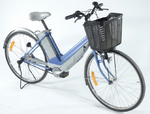D
Deleted member 4210
Guest
E-Bikes have been utilized in Japan for over 25 years. Not a lot of Americans who know about ebikes, realize this. Yamaha of course has been a big player there. Interesting to note as mentioned in the article, Japan as a country, has crossed the 500,000 annual unit ebike sales mark in recent years, which apparently represents about 10% of all unit sales for bikes sold there.
The US has a LONG way to go, for ebikes to reach 10% of its unit sales of all bikes. It won't likely happen very fast, since Americans love their cars, pretty much shun public transportation except for a few large cities, has relatively poor biking infrastructure compared to other countries, however ebikes might be the catalyst here to help change that. So in this case, slow and steady wins the race, and its more likely to be a marathon. Hence, the huge number of ebike firms introducing product, aren't likely to last. Many are not making good business decisions, often rushing junky things to market, or doing really dumb things on pricing vs value delivered. Too many gimmicks as well, which could come back to haunt them, if they lose their own consumers, or turn people off ebikes. (the stupid e-scooter sharing onslaught is one of many unintelligent examples)
(By the way, Yamaha is in this for the long run here in the US. But they've 'been there, done that' in Japan for many years, and being in the ebike market for far longer than even many EU ebike firms. I expect a lot of US firms will find themselves eventually playing catch up to them, despite their delayed introduction to the US last year.)
Anyway, its a brief article, but intended to expand awareness of what is going on in the world of e-bikes outside of the US. This is really NOT a new market - but with newer emerging battery technology now helping it along a little faster than it was before lithium batteries reached a good price point - I have been following it since the late 1990's. Like the culture in Japan, I've taken my time studying it, observing, learning patiently before putting my now additional time and money into it.
Sometimes little articles like these can be great to learn from, without saying a lot.
https://www.japantimes.co.jp/news/2...years-yamaha-motors-first-model/#.XGmOKaJKg-0
The US has a LONG way to go, for ebikes to reach 10% of its unit sales of all bikes. It won't likely happen very fast, since Americans love their cars, pretty much shun public transportation except for a few large cities, has relatively poor biking infrastructure compared to other countries, however ebikes might be the catalyst here to help change that. So in this case, slow and steady wins the race, and its more likely to be a marathon. Hence, the huge number of ebike firms introducing product, aren't likely to last. Many are not making good business decisions, often rushing junky things to market, or doing really dumb things on pricing vs value delivered. Too many gimmicks as well, which could come back to haunt them, if they lose their own consumers, or turn people off ebikes. (the stupid e-scooter sharing onslaught is one of many unintelligent examples)
(By the way, Yamaha is in this for the long run here in the US. But they've 'been there, done that' in Japan for many years, and being in the ebike market for far longer than even many EU ebike firms. I expect a lot of US firms will find themselves eventually playing catch up to them, despite their delayed introduction to the US last year.)
Anyway, its a brief article, but intended to expand awareness of what is going on in the world of e-bikes outside of the US. This is really NOT a new market - but with newer emerging battery technology now helping it along a little faster than it was before lithium batteries reached a good price point - I have been following it since the late 1990's. Like the culture in Japan, I've taken my time studying it, observing, learning patiently before putting my now additional time and money into it.
Sometimes little articles like these can be great to learn from, without saying a lot.
https://www.japantimes.co.jp/news/2...years-yamaha-motors-first-model/#.XGmOKaJKg-0




